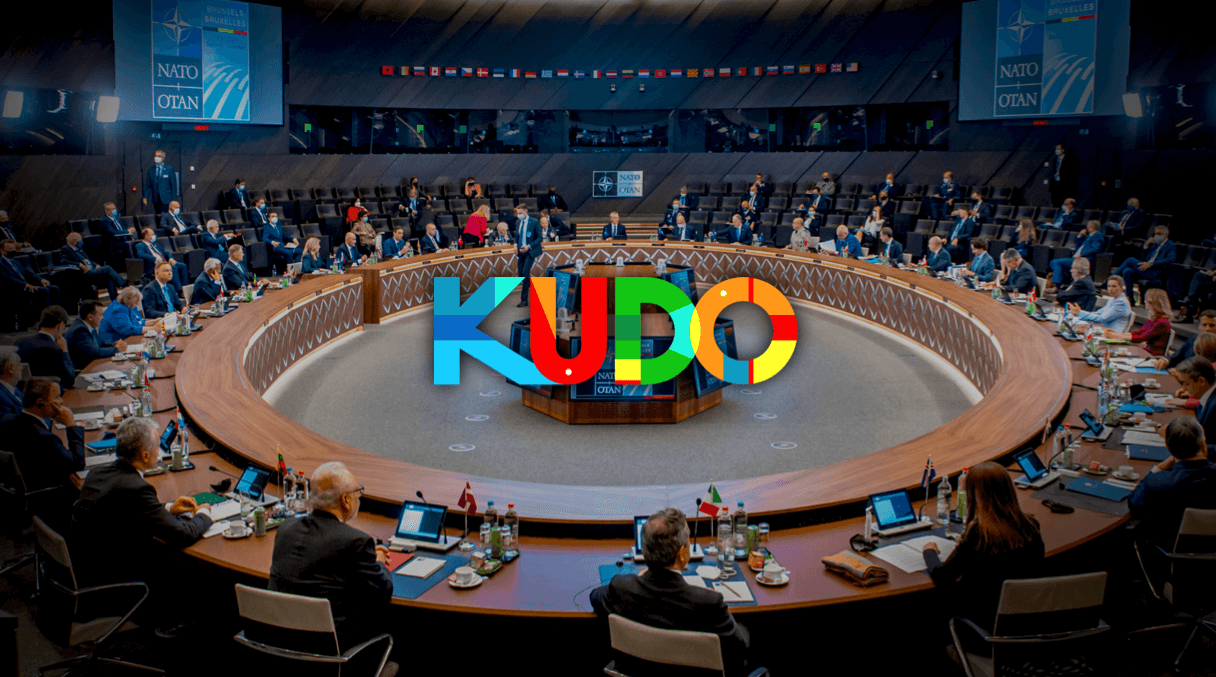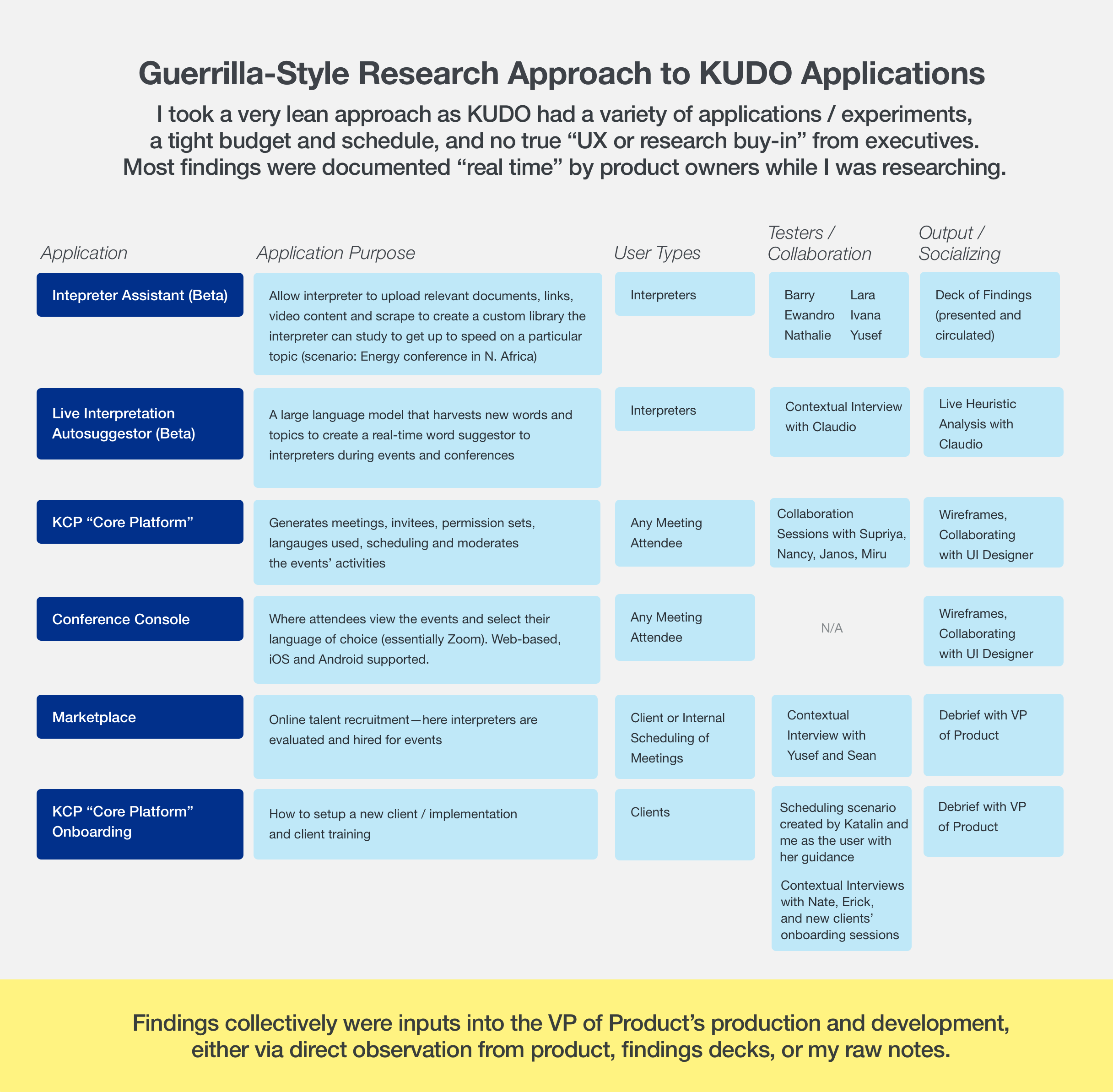KUDO
Multi-Language Conferencing
KUDO products range from multilingual conferencing logistics to AI-powered live interpretation applications.
KUDO applications are used by organizations such as the European Parliament (EU), Interpol, NATO, the United Nations–wherever there's need for multiple languages to be in conversation simultaneously.
The Situation
This Series A-funded, Manhattan-based startup was founded by Fardad Zabetian, a tech expert in the live interpretation space, and a small group of highly-skilled interpretation thought leaders. The company initially managed hardware and software for physical booths in multi-language locations and events.
KUDO was venturing into the digital space with some of their products, and were adopting a more product team mindset. They had received an enormous spike in customers and usage due to the onset of Covid—and their applications and implementation team were stretched way beyond their limits.
I was brought in by the VP of Product who was attempting to build out and educate the company towards a product model. She aimed to introduce usability testing and iterative design, and in-parallel create a product team of owners and managers delivering Agile methodology to the tech team.
Objectives
I had narrow objectives to explore their broad product suite,
and advocate for UX in as many 'channels' as possible.
- Give feedback to VP of Product around "the state" of the applications
- Help a startup become "product-minded"
- Show the value in UX research to fund
more discovery, usability, and intelligence-driven decisions
- Give current UI and localization team direction and user feedback
- Convert "research" from a bad word (was told
not to use the word "research") in the executive
leaders' minds into something valuable and necessary
- My personal objective was to develop a product scorecard
and product-level strategy for each, but the VP of Product
owned that space. Also products were spun up
and cancelled too quickly to make that exercise valuable.
- Give feedback to VP of Product around "the state" of the applications
- Help a startup become "product-minded"
- Show the value in UX research to fund more discovery, usability, and intelligence-driven decisions
- Give current UI and localization team direction and user feedback
- Convert "research" from a bad word (was told not to use the word "research") in the executive leaders' minds into something valuable and necessary
- My personal objective was to develop a product scorecard and product-level strategy for each, but the VP of Product owned that space. Also products were spun up and cancelled too quickly to make that exercise valuable.
Interpreter Overview
They are a fantastic and fascinating group of people. I had expected them to be rigid in their method and thinking, but what they do is art. They are not "translating" word-for-word, as I had thought—but they are "interpreting" like poets to bring meaning and color to the conversation.
All of the employees I had met who had roles other than interpretation had a love for language, as well as a passion for precision and expressiveness in their word choices. As a UX professional who strives for both literal and visual perfection and aims for mutually satisfying conversations, I easily connected with them.
One French woman, who interpreted between English and French, met someone from Portugal in her twenties. She couldn't believe the beauty of the Portuguese language and was transfixed by how the words were formed. She said to me, 'I told him to keep speaking, and I don't care what you say—I just want to see how you form the words!' She was so determined to immerse herself in the language that she moved to Argentina and never looked back.
Another interpreter was a former Chief Interpreter
for the United Nations, who interpreted for six presidents,
numerous EU leaders, and had a native command of
English and Portuguese. He was fluent in Spanish,
French, Italian, and German. He shared a quote with
me that has stuck with me:
If you talk to a man in a language he understands, that goes to his head.
If you talk to him in his own language, that goes to his heart.
I accidentally misconjugated a verb in my (English) user testing script, which I'd asked 6 interpreters to read aloud. 6 out of 6 hesitated or commented on it!
Tactics
With the VP of Product, we brought user-centered design to company with the following approaches:
1) Advocating for UX Maturity
I'd authored and socialized an "Intro to UX" deck to leaders, interpreters, designers and engineers. C-Suite Product Executives were aware of their poor product feedback, but remained guarded and hesitant. They were skeptical about UX in general—and were envisioning resources being tied up and more spending dev hours than they wanted to commit.
However, C-Suite Interpreter Executives and implementation leads were excited and became advocates themselves, now that they understood UX as a direction. There was definitely a disconnect between the two camps, and would have like to explore differing views given more time and budget.
Evidence-Based User Experience Design.pdf2) Establish a Usability Research Framework
Created a moderated testing kit to be used by the UI designers and localization
Email Invitation Template.txtModerator Script.doc
Participant Warm Up.pdf
Scenario and Activities.doc
Observer Tips.pdf
Post Task Participant Survey.pdf
Research Test Plan Template.doc
Severity Rating Matrix.xls
3) Interpreter AI-Assistant - Moderated Research
Ran 2 pilots and 6 moderated usability sessions with an AI-based application, made to assist interpreters in custom glossary creation.
Interpreters' events are often within specific technical, scientific, or manufacturing domains. They typically receive the topics or agendas but rarely receive deeper documents. They always need to study up on the subject matter and typically search for proper nouns such as people, places, and specific items.
The Interpreter AI-Assistant can scrape URLs, videos, PDFs, audio files, and transcripts to allow the interpreter to build a client- or event-based glossary. The interpreter can then study the subject matter before the event. Through machine learning, the overall or "global" database (KUDO-owned) of industry-specific words becomes stronger.
Some examples:
to "Aerodynamic downforce" (ENG)
to "Vector thrust engine" (ENG)
to "Catalyst poisoning" (ENG)
Usability Test Raw Notes.xls
Usability Test Findings.pptx
Other Applications
I'd also made minor contributions to the following:
Methodologies
- Contextual Inquiry
- Direct Observation
- Moderated User Testing
- Scenario Creation
- UI Refactoring
- Wireframing
Outcome
I was able to make a positive impact on the interpretation-side stakeholders as well as with their lead innovator. They were glad to know a UX framework existed to help them create a better product, reduce errors and potentially shorten the client onboarding (4 hour sessions).
The product director and founder were very skeptical of adding more people and initiatives to products. And I was told directly "UX research is nothing but a waste of time" and in other direct ways.
The VP of Product had taken that battle under her wing, and was approaching the C-Suite with her own direction— so she'd asked me to stand down in many occassions. I hadn't learned about what came of her efforts, but saw she'd no longer worked with the company shortly after my time had ended.
On a personal note, I learned about localization, some nuances and importance with dealing with different languages and cultures. I'm still pursuing learning more about that space.
I also learned there are ratings or levels of fluency called the CEFR framework. And that motivated me to pursue learning languages as a hobby.
Next Steps
Ideally, I would have pursued the following:
- Product and C-suite interviews
- UX research cadence to provide C-suite insights
- Usability testing for localization
- Product "scorecards" (measure health, goals, issues)
- Interpreter workspace analysis
- More UI refactoring of conference console



